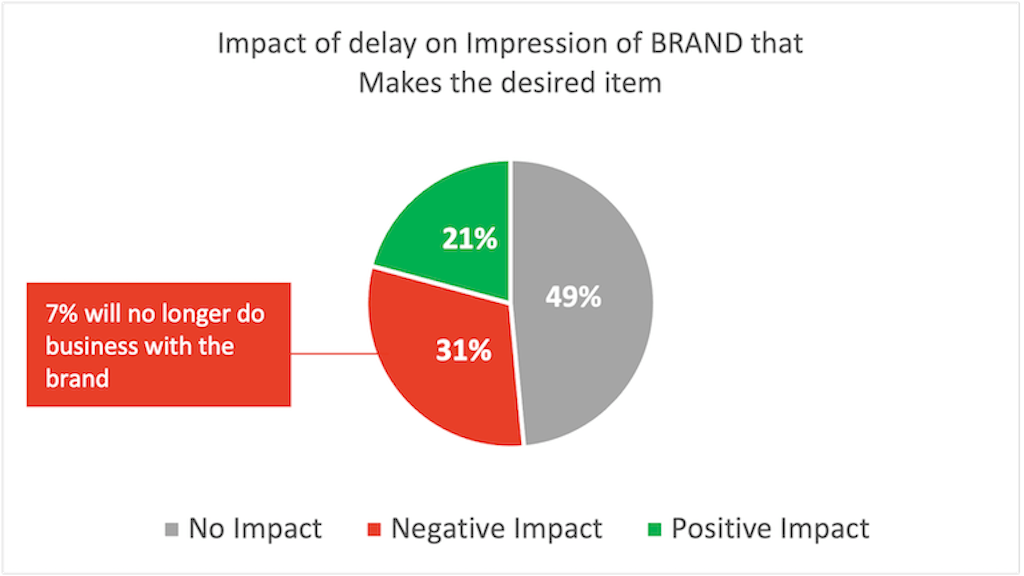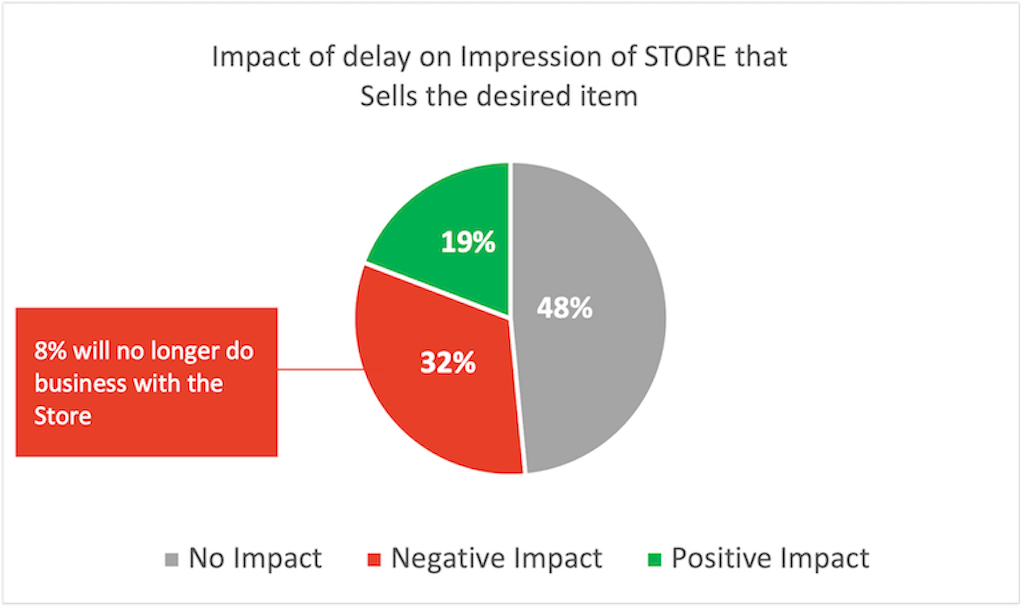Impact of Supply Chain Issues on Business
Nearly every Fortune 1000 company is experiencing supply chain disruptions. A staggering, but understandable, portion (75%) have seen a negative impact on their business and over half (55%) have downgraded or plan to downgrade their growth outlook as a result of continued issues1.
With vendor supplies running low or depleted and labor yet to return to pre-pandemic levels, all aspects of the supply chain from manufacturing to distribution to service have been negatively impacted. Customers express frustration as they seek out pre-COVID experiences and find them to be very different, often disappointing, in comparison to expectations from memory. Retailers struggle to keep items in stock, vendors scramble for parts and manufacturers seek out new ways to get the materials that they need to continue production. With all the constraints that organizations are facing, it is easy to understand the increased uncertainty, reductions in growth goals and customer discontent.
While it may feel like supply chain difficulties are completely out of the control of individual corporations, there are ways to create opportunities for future efforts by evolving business practices in a calculated manner. In this post, we will and review and discuss guidance from well-known consulting firms, Accenture, BCG, Gartner and KPMG related to combating supply chain issues. Additionally, we’ll present initial learnings from the early days of the COVID-19 pandemic obtained through interviews with 72 of Big Village’s B2B expert panellists to highlight the length of time various supply chains issues, mitigation strategies and technology enhancements have been a source of discussion. Finally, we’ll present the impact of supply chain issues, mainly product delays, on consumer impression of the stores that carry desired, yet unattainable, items and the brands/manufacturers that make these products.
Supply Chain Improvement Advice from Consulting Firms & Big Village B2B Experts
While each firm takes a slightly different position, a constant set of themes emerge which are focused on data, technology, employee involvement and customer centricity. Accenture advises evolving digital to unlock data, rethinking your operating model and building an asset-light network. KPMG stresses the importance of customer centricity, transparency and the significant role of technology, upskilled workforce, use of robotics on the line and in the warehouse, artificial intelligence and machine learning combined with customer driven micro supply chains to increase autonomy in ordering2. BCG advocates for a strong agile approach backed by a willingness to invest in technology and increased use of data science and digital proficiency, including a significant labor upskilling component and assigning responsibility for progress within individual business units3. Gartner highlights the organizations that have made great strides in upgrading their infrastructure and supply chain management with a strong customer centric focus and environmentally cognizant mindset4. Companies of note such as Unilever, Cisco, L’Oréal, Nestle, Intel, Lenovo BMW and Starbucks are recognized for a variety of innovations including:
- Offering customization
- Exploring new ways to move product to customers
- Increasing customer autonomy (micro supply chains) and automated customer service
- Implementing close-loop feedback processes between customers and research & development to aid in the design of future products
- Addressing environmental concerns, sustainability, and support of advancing technology to reuse parts, repurpose waste for use in manufacturing, monitor impact of manufacturing processes on the environment and avoidance of suppliers that ignore the impact of their actions on overall planet health
Big Village’s B2B experts discussed several strategies to mitigate supply chain issues during the early days of COVID-195. Diversification of supply chain and accelerated adoption of technology along with revised business models rose to the top, with diversification emerging as the main strategy for coping with supply chain challenges and issues. It is fair to say that these strategies remain highly relevant in present day.

Drilling deeper into technology adoption, our experts indicated robotic process automation as the most often adopted technology. This along with implementation of robotics likely was a focus to facilitate production in a safer environment for human workers. Implementation of artificial intelligence and 3D printing were also being adopted by about one-quarter of B2B organizations to make the best use of the supplies they had and get innovative in making pieces and parts that they formerly depended upon others to provide.

Strategies and technology are helpful, but we cannot lose sight of the human component. The true test of strategy and tech adoption will be in how beneficial they are in improving customer experience. Whether a B2C or B2B relationship, maximized human capital, continued human interest, responsible sourcing behavior, greater reliance on and integration of technology, implementation of AI, IoT and machine learning to gather data necessary to make better informed decisions and projections is a must for future success. Continuing to listen to the voice of your customer, keeping them informed and accurately managing expectations around delivery can help alleviate supply chain related disappointments
Impact of Supply Chain Disruption on Customer Experience
The first step in managing any issue is understanding how much of an impact it is having. Recently Big Village asked how large the impact of supply chain disruption is on customer experience and what if any negative repercussions these issues are having on brand and retailer impressions/perceptions.
In our recent survey of 1004 general US consumers, we found that most consumers (73%) have experienced a delay acquiring an item that they wanted or needed. Of those experiencing a delay, 35% attribute the delay to backorders and a delay in manufacturing; 30% cite inventory shortages and shipping delays and 20% say delays are caused by a lack of parts to make their desired item.
Interestingly, most customers appear very understanding with half of all customers who experienced a delay expressing a willingness to wait for the exact item they wanted. About one-third were able to find an acceptable substitute and 16% completely abandoned the pursuit of the item or a substitute.
Customers who chose to go with a substituted item are finding these solutions with very little help from retailers or manufacturers with 72% pursing an alternative on their own. Just over one-quarter of customers say that the store/merchant provided a recommendation for another product and only 2% were told of a possible substitution by the original item manufacturer.
Given that about nearly one-third of US customers are willing to accept a substitute and most of them receive no assistance in locating this substitute, retailers and manufacturers have an opportunity to recover potentially lost revenue by proactively recommending an alternative solution.
Half of the customers who are willing to wait for the exact product they desire will wait up to three weeks. Another 41% will wait up to three months while very few (8%) will wait six months to one year. Regardless of the time they are willing to wait customers cited the same reasons for exercising patience. These customers were particular about the specific item that they wanted (40%), weren’t in a hurry to get their item (36%) or couldn’t find an adequate substitute item (23%).

A third camp of customers abandoned the item entirely. These customers just didn’t have the patience, desire, or faith necessary to wait for their item. Uncertainty about the length of the wait for their item, items not being worth waiting for, inadequate substitutions and the perceived lessor quality of a substitution were the main reasons given for abandoning the item all together.

So How Does this Current Situation Impact Customer Experience?
Most customers who experienced supply chain issues were very to somewhat satisfied with their experience (57%). About one-quarter of these customers were indifferent and about one-in-five were somewhat or very disappointed. When asked to compare their actual experience to their expectations, most customers said that it was what they expected (58%), very few (13%) said their expectations were exceeded and 30% said that the experience failed to meet their expectations.
Despite a high portion of customers expressing dissatisfaction and reporting a substandard experience versus expectation, many say that these delays have little impact on their view of the brand or manufacturer. It is worth noting, however that a sizable portion of customers indicated their impression of the brand and/or manufacturer is more negative after their recent issues than more positive. Fortunately, fewer than one-in-ten customers say that this issue will prevent them from doing business with the retailer or brand in the future.


Where Do We Go from Here?
There is a general understanding globally that supply chain issues are affecting every company. Innovative and communicative organizations who stay ahead of customer expectations will find their customers to be appreciative of their outreach and transparency. In-store signage is very helpful in managing expectations. We see shipping companies or ecommerce retailers relying on shipping companies proactively warning customers that natural disasters such as flooding or fires in areas of the country will delay shipments, the same principal can hold true at the shelf. In retail situations, consider posting signs when an item is discontinued to proactively communicate this to your patrons. This is an acknowledgement that their time is valuable. Constantly checking back for an item only to eventually find that it has been discontinued can be highly frustrating. If a popular item has been out-of-stock for an extended period or will be out-of-stock for an extended period, communicate this knowledge to your customer base.
Retailers like Costco, Target and Wal-Mart were very helpful to patrons during the early days of COVID posting signs outside of their locations letting customers know if the items they needed (toilet paper, paper towels, Clorox wipes, etc.) were available before the customers needed to enter and find out at the shelf.
For larger ticket items, communicating up front the estimated time frame for delivery is very important. A friend of mine recently decided to invest in a hot tub. She was very disappointed to learn that it could not be delivered for six months. A few calls later, she was able to find a company that did higher volume sales and could deliver her order within 10 weeks. Not a great timeline either but in the context of six months, it seemed like a huge win.
In the case of B2B supply and vendor management, digital interventions and data analytics will continue to be critical in understanding, planning and management. Knowing where supply is, how much is needed where and when relative to demand, will allow companies to wisely invest their limited resources in ways that will help their customers.
Big Village Is Here to Help
Supply chain management is not a simple process and has become even more demanding in the wake of COVID-19. The best way to maintain a sense of control is to collect more data for use in structured planning, management, and communication. Investing strategically in technology, data analytics, artificial intelligence and IoT along with updating your customer experience knowledge will help your organization focus on the things within your control that are in the most need of attention according to your customers.
Customer experience has changed drastically for many organizations given new touchpoints and a new lens through which many now view the world. To account for changes in customer perception, interaction with your brand and overall satisfaction with your brand it is critical to refresh your knowledge of overall CX.
Big Village’s B2B, Data Analytics, CX and industry experts immerse themselves within your organization to collaboratively design a plan unique to your needs, business objectives and customers’ desires. We meet you where you are and work with you to constantly evolve and expand your knowledge and actions to maximize business outcomes.
Let us know what you are tasked with solving and the challenges you face. We’ve encountered them and are ready to create a plan that is right for your unique organization.
Written by Nicole Garberg, VP of Customer Experience at Big Village Insights.
References
- https://www.accenture.com/us-en/insights/consulting/coronavirus-supply-chain-disruption
- https://advisory.kpmg.us/insights/future-supply-chain.html
- https://www.bcg.com/publications/2021/accelerating-past-digital-journey-inflection-point
- https://www.gartner.com/smarterwithgartner/the-gartner-supply-chain-top-25-for-2021/
- https://big-village.com/insights/blog/covid-19-accelerates-technology-adoption-in-manufacturing-to-mitigate-resource-impacts/

